March 4, 2021
 President Biden this week announced that enough COVID-19 vaccines will be available for all U.S. adults by the end of May. The FDA approvals, varied distribution protocols by state and rollout of the coronavirus vaccine bring with them a fresh set of challenges for employer-employee communications. While some states have prioritized food and agriculture workers for vaccine eligibility, others have not.
President Biden this week announced that enough COVID-19 vaccines will be available for all U.S. adults by the end of May. The FDA approvals, varied distribution protocols by state and rollout of the coronavirus vaccine bring with them a fresh set of challenges for employer-employee communications. While some states have prioritized food and agriculture workers for vaccine eligibility, others have not.
In December 2020, the Equal Employment Opportunity Commission affirmed that businesses and employers may require employees to receive a vaccination as a condition of continued employment and can require proof of COVID-19 vaccination. Employees who refuse to be vaccinated can be banned from the workplace.
How can employers lead their teams through this new conversation? Smart communications will strike a balance between education and data with empathy and values. These recommendations will position companies for success:
- Communicate in a way that is consistent with other company messaging on health and safety topics (like the flu vaccine and other preventative care). For a company that has prioritized communicating about employee well-being, promoting the COVID-19 vaccine should align with that strategy.
- Provide a clear explanation of company expectations. If the vaccine will be required as a condition of employment, share that information with clarity and transparency. Describe any protocols the company will have in place and what is expected of employees in terms of timing and documentation.
- Create and deploy a cadenced communications plan. The vaccine will not be available consistently for some time. It is good to begin outlining the company’s plans and a positive message about vaccination,
 but do not be premature by sharing too much too soon. Align with the public conversation on the topic and cadence communications to increase in frequency as access to the vaccine approaches.
but do not be premature by sharing too much too soon. Align with the public conversation on the topic and cadence communications to increase in frequency as access to the vaccine approaches.
- Remember employees are people, too. Remember that opinions of the company’s employee base likely reflect the general national breakdown of attitudes about the vaccine. That means about half of a company’s team is skeptical about the vaccine and may not intend to be vaccinated. Going in with a “vaccinate or else” message is sure to fail, while a well-crafted set of messages will build a favorable climate for future vaccination requirements.
- Provide clarity around company plans. Work with company HR leaders to fully define plans for employee vaccination. Will the company provide onsite vaccination? Must employees bring in proof of vaccination? Do company insurance benefits cover the vaccine? Is there a grace period for when employees must have the vaccination completed? Will the company provide paid time off if employees fall ill from vaccine side effects?
- Reinforce relevant CDC and public health recommendations about the vaccine. Provide vaccine resources for employees from recognized public health experts. Make information accessible and easy to understand. Make sure it is translated in all necessary languages.
- Leverage company values. Vaccine communications should lean into the values of the company. Assure employee vaccine requirements reflect a commitment to the care and well-being of employees. Remind the team that protecting health and safety matters for their welfare, for operational continuity and for prevention of virus spread in the community.
- Rely on measured and straightforward communications. As communications roll out, create a deliberate stream of frequent, accessible information for employees that is easy to understand. Consider developing resources such as FAQs, fact sheets, break room fliers and other materials that reiterate the company’s position.
- Create feedback circles. Because the COVID-19 vaccination remains a concern to many, be intentional about providing two-way communication for employees to ask questions, raise concerns or share their opinions in a way that is safe and without risk of retaliation. Assure that managers and supervisors understand the need to be engaged and empathetic.
- Be patient. All states, and all employment sectors, will not have the earliest access. Give employees time to get comfortable with the vaccine and to see its early successes.
Now is the time for an organization to communicate effectively about vaccination policies. Ultimately, companies should begin communications with the end in mind -- a safe, healthy and vaccinated workforce. This article was adapted from an article published in Smart Brief, written by UEP’s PR Consultant Hinda Mitchell.
![]() President Biden this week announced that enough COVID-19 vaccines will be available for all U.S. adults by the end of May. The FDA approvals, varied distribution protocols by state and rollout of the coronavirus vaccine bring with them a fresh set of challenges for employer-employee communications. While some states have prioritized food and agriculture workers for vaccine eligibility, others have not.
President Biden this week announced that enough COVID-19 vaccines will be available for all U.S. adults by the end of May. The FDA approvals, varied distribution protocols by state and rollout of the coronavirus vaccine bring with them a fresh set of challenges for employer-employee communications. While some states have prioritized food and agriculture workers for vaccine eligibility, others have not. but do not be premature by sharing too much too soon. Align with the public conversation on the topic and cadence communications to increase in frequency as access to the vaccine approaches.
but do not be premature by sharing too much too soon. Align with the public conversation on the topic and cadence communications to increase in frequency as access to the vaccine approaches.